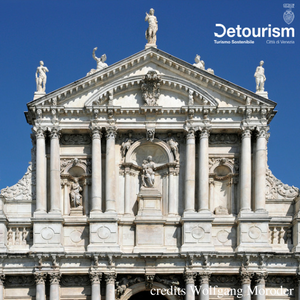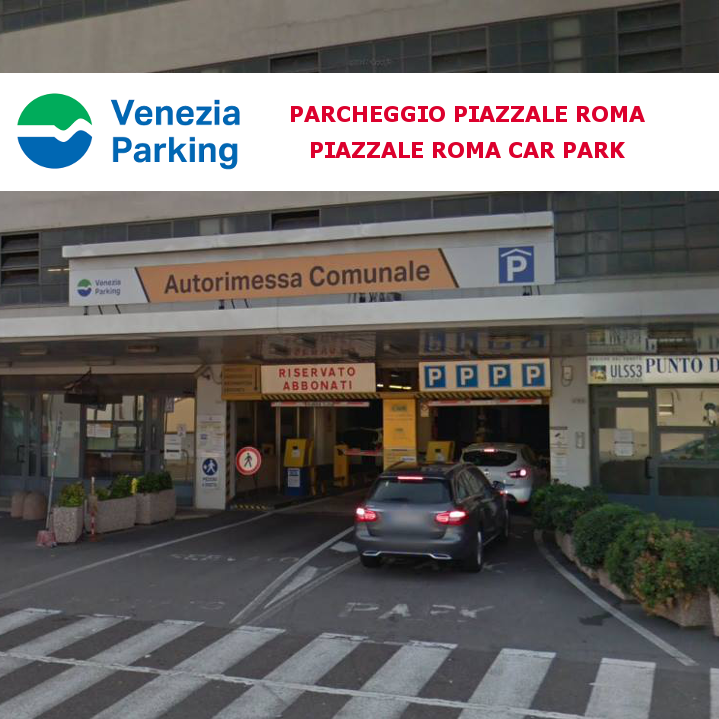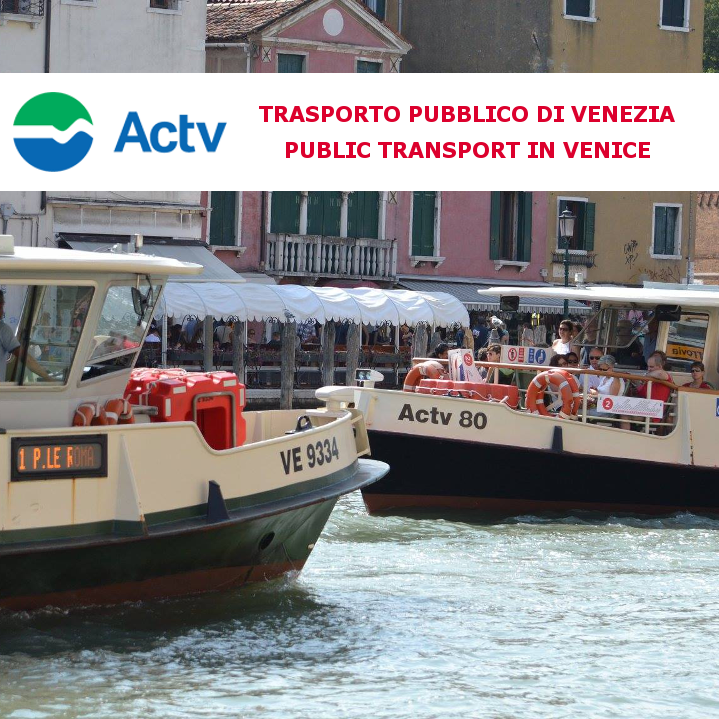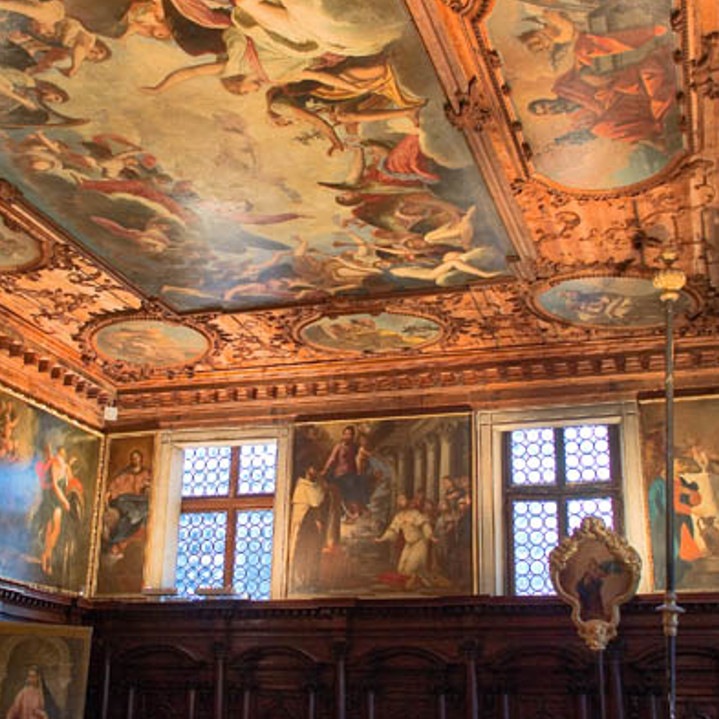You are here
Cannaregio district
This itinerary will take you to discover the Cannaregio district, one of the largest and most populated of the city, with a characteristic configuration of endless parallel canals lined with wide fondamente joining bridges and narrow streets. You can decide to follow the main itinerary that will take you to the most famous places in Cannaregio or lengthen it by following some variations that will soon bring you back to the main route and our destination, Rialto.
 Our starting point is the Venezia-Santa Lucia railway station. A great deal has been said about this, for better or for worse: if you are curious, before starting your journey, go and see the famous four bridges spanning the Grand Canal, including the Ponte della Costituzione (2009), designed by the architect Santiago Calatrava; a modern structure that connects the station to Piazzale Roma. From the top of the bridge there is a view that, like the bridge, is a real innovation.
Our starting point is the Venezia-Santa Lucia railway station. A great deal has been said about this, for better or for worse: if you are curious, before starting your journey, go and see the famous four bridges spanning the Grand Canal, including the Ponte della Costituzione (2009), designed by the architect Santiago Calatrava; a modern structure that connects the station to Piazzale Roma. From the top of the bridge there is a view that, like the bridge, is a real innovation.
Return to the station, head along the fondamenta degli Scalzi where stands the Church of Santa Maria di Nazareth, called the Scalzi; a grandiose Baroque building whose ceiling - decorated by Giambattista Tiepolo - was destroyed by an Austrian bomb in 1915. Inside the church there are other frescoes by Tiepolo, a majestic altar and the tomb of the last Doge of Venice, Ludovico Manin.
Go further along Lista di Spagna (i.e. Spain street - as was once named the stretch of road facing an embassy in which diplomatic immunity was granted) to Campo San Geremia and the church of the same name, where, in 1860, as a result of the destruction the church of Santa Lucia on whose site the railway station was built, the remains of Santa Lucia, Saint of Syracuse, much loved and venerated by the Venetians, were transferred. The campo features the impressive façade of Palazzo Labia, home of a rich family of Catalan origin associated with the Venetian nobility in the seventeenth century. The interior preserves a famous fresco by Giambattista Tiepolo which illustrates episodes from the stories of Anthony and Cleopatra.
Continue towards the Ponte delle Guglie, so called for the four obelisks that decorate it, that spans the Cannaregio Canal, the main artery of the city. It, together with the Grand Canal and the Giudecca Canal, is a canale and not, as is normal for the other waterways, a rio.
If you want to follow the main route, cross the bridge and turn left along the fondamenta di Cannaregio up to an arched portico on your right indicated by a yellow sign in Hebrew that leads to the Ghetto.
First variation
Do not cross the Ponte delle Guglie, but immediately turn left along Fondamenta Venier. If you have time you can visit the enormous garden - now public – once annexed to the Palazzo Priuli-Manfrin (now Venier) Palace, famous for its nature and rare plants.
You arrive at the Ponte dei Tre Archi, the only bridge with three arches in the city. In line with the bridge is Campo San Giobbe with its homonymous church built in the gothic style and later remodelled in the Renaissance style, with an elegant portal and a presbytery of great beauty. Inside you will see the beautiful Martini chapel, penultimate on the left hand side, with its magnificent ceiling covered with multi-coloured glazed earthenware, only example in Venice of the art of Della Robbia.
Continuing along the last stretch of the fondamenta that reaches the northern lagoon, lined with small restaurants, crossing an area that once housed numerous productive activities recalled by the names of the streets, you reach the neoclassical building of the former municipal slaughterhouse, which now houses the Faculty of Economics of the Ca' Foscari University. The university's location here has greatly contributed to the revitalization of this area which was once peripheral.
Return to the Ponte dei Tre Archi, cross it, and at this point you can choose to venture further into one of the lesser known areas of the city or turn right along Fondamenta di Cannaregio, to return to the main route.
If you decide to return to the main route descend to the right along the Fondamenta di Cannaregio, where you will find the seventeenth century Palazzo Surian that was used as a French embassy and hosted Montaigne and his secretary Jean Jacques Rousseau, and the sixteenth century Palazzo Nani. You arrive at an archway on your left indicated by a yellow sign in Hebrew which gives access to the Ghetto Vecchio.
If instead you opt to extend the first variation, after crossing the Ponte dei Tre Archi turn left and you arrive at number 923 of the sixteenth-century Palazzo Roma, and immediately on the right you enter the portico and Corte Feraù. Go straight ahead along Calle Feraù, take a right turn into Calle Corner and then left into Fondamenta delle Case Nove. The wide area along the left up to the north lagoon, named sacca di San Girolamo, was sold in the last century to build one of the first public housing complexes between the two world wars.
You arrive at the Ponte Moro, and continue along Fondamenta Moro or Coletti. The Moro fondamenta is incorporated into the Fondamenta delle Cappuccine, named after the seventeenth-century monastery of which only the church with brick façade remains. Further along the fondamenta stands the Palazzo Grimani of the late 14th century. Continue along the fondamenta, over the Ponte delle Torrette, turn left into Calle Turlona, cross the bridge of the same name and turn left along the Fondamenta della Sensa, then turn right into Calle dei Riformati and cross the San Bonaventure bridge. You arrive at Fondamenta dei Riformati, the last of the three parallel lines that characterize the northern slope of Cannaregio.
Go right up to Campo San Alvise where stands the church of San Luigi di Tolosa, in Venetian Alvise. Erected in the fourteenth century, the church has been rebuilt and restored. Inside is a work by Giambattista Tiepolo. Cross the Ponte di San Alvise to the right and go down Calle del Capitello that leads back to Fondamenta della Sensa, cross the Ponte della Malvasia and continue along Calle Malvasia until you reach Fondamenta degli Ormesini which is the continuation of the Moro and Cappuccine. Turn right onto the Ponte del Ghetto Nuovo iron bridge. Cross the Ghetto Nuovo and the Ghetto Vecchio to arrive at the Cannaregio Canal. You have now rejoined the main route.
Main route
The Jewish Quarter (Ghetto Ebraico) was established by the Seigniory in 1516. The word “ghetto” is derived from the metal foundries (geti) that once occupied the area. The foundries closed and the area was granted to the Jewish community, who previously had been denied the possibility of permanent residence in the city. Despite the name, the most ancient original nucleus of the settlement is the Ghetto Novo, where Jews of German, French and Italian origin settled. With the arrival of the Sephardic Jews, the Ghetto Vecchio was annexed, located on the adjacent island, where the oldest foundries were once. In the Ghetto Vecchio, in the Campiello delle Scuole two synagogues (called schole) were established in the second half of the sixteenth century - the Levantina and the Spagnola or Ponentina – which are still in use, while in Campo del Ghetto Nuovo there are the most ancient, the Schola Grande of German ritual, the Schola Canton and the Scuola Italiana, today part of the Jewish Museum.
After crossing the Ponte del Ghetto Novo, turn right and follow Fondamenta degli Ormesini and della Misericordia, named after their respective rivers. Turning left into Calle Larga you move to the parallel Rio della Sensa where you find Campo dei Mori, known for the three statues that represent the three brothers Rioba, Sandi and Afani, merchants in Venice in 1112 from the Morea, the ancient name for the Peloponnese. From here plausibly thus originated the name “dei Mori” (“the Moors”) though, according to another theory, it could denote the presence of an ancient warehouse used by Arab merchants. A little distant, there is a fourth mysterious statue that, according to tradition, represents their servant. This statue is on the corner of a Gothic palazzo, the home of Jacopo Tintoretto, where the Master died in 1594.
From Campo dei Mori, crossing the river, you arrive in the area where stands the Madonna dell'Orto churc whose façade is the most complete surviving example of Venetian Gothic of the early fifteenth century. Inside, among other distinguished works, are preserved huge canvases by Tintoretto, who is buried in the chapel to the right of the apse.
Proceed along Fondamenta Contarini. Beyond the river you see the gothic “House of the Camel”, so called due to the curious bas-relief of a man driving a camel on its façade, also known as Palazzo Mastelli, property of the three brothers who came from the Morea who in Venice adopted the name Mastelli (apparently from the bowls of money they possessed). Connected is the Sacca della Misericordia, where once wood was stored after being floated down to Venice from the Cadore mountain region, and which now looks like a grand marina. You return towards the Rio della Sensa, along the foundations of the Abbey to the Campo dell’Abbazia della Misericordia, one of the most fascinating corners of the city. In the Campo there is the lovely façade of late High Gothic style of the Scuola Vecchia della Misericordia (one of the lay brotherhoods of assistance and devotion) and the seventeenth-century church of Santa Maria in Valverde. Beyond the river you notice the imposing and unfinished Scuola Nuova della Misericordia, initiated from a design by Jacopo Sansovino as the new home of the brotherhood.
Cross the bridge and proceed alongside the Scuola, turn left towards Fondamenta di San Felice where you can see a rare surviving example of a bridge without parapets, as it was used in ancient times. To follow the main route, continue along Fondamenta di San Felice to its junction with the Strada Nova. Here you turn left, cross the Ponte di San Felice and continue to Calle della Ca' d'Oro on your right.
Second variation
Cross the rio and take the Sotoportego dei Preti, then turn left into Calle Racchetta, and you arrive at the Fondamenta di Santa Caterina, of the eponymous church, and the Fondamenta Zen, from the palace of the ancient family of two celebrated navigators, Nicholas and Antonio. You have now reached the Campo dei Gesuiti, where stands the church of the same name; an imposing and rich baroque building decorated inside with a damask tapestry, stuccoes, statues, marble inlays and gilding, and which also contains works from the previous 16th century church, property of the order of the Crociferi, including the famous Martirio di S. Lorenzo (Martyrdom of St. Lawrence) by Titian and a Vergine Assunta (Our Lady of The Assumption) by Tintoretto. Opposite the church there are the Ospedale and Oratorio dei Crociferi, one of the many secret gems of the city with one of the best cycles of paintings by Jacopo Palma the Younger.
From the Chiesa dei Gesuiti there are two ways to rejoin the main route:
- Retrace your steps across the piazza, cross the bridge and proceed along the calli and rii terà (buried canals) to the piazza Santi Apostoli where, on the right, is the Strada Nova. Turn right, past Campo Santa Sofia, and turn left on Calle Ca' d'Oro. You have returned to the main itinerary.
- cross the bridge, turn to the left of the beautiful Palazzo Sceriman along Calle Venier until you reach Campiello della Pietà, turn left on Calle della Pietà, the wide street of the Boteri, where at No. 5113 is the rear entrance to what was the home of Titian for many years and where the painter died in 1576, then turn into Calle Croci, and you reach the Fondamente Nòve.
This wide bank is so named because it was only constructed at the end of 16th century. It forms the northern limit of city. Along the Fondamente Nòve lies the beautiful Palazzo Donà, built by the Doge Leonardo Donà early in the seventeenth century. From the Fondamente Nòve you can enjoy a beautiful view of the island of San Michele, the Venetian cemetery, and the island of Murano, famous throughout the world for the production of glass.
Then turn right along Calle del Fumo until you reach Piazza Widmann and Calle Widmann. Go over the bridge and then cross the piazza on your right where you will find the church of San Canciano. Of ancient foundation, the current building dates back to the 16th century, while the interior was remodelled in the 18th by Giorgio Massari. You cross the bridge (touch the iron hook on the wall on your right. You never know... it may bring good luck!) and proceed into the small Casona square, through the piazza Santi Apostoli, and then along the Strada Nova to the Calle Ca' d'Oro where you rejoin the main route.
Ca' d'Oro, one of the most monumental buildings in the city, with a magnificent façade on the Grand Canal. It was built in Gothic style in the first half of the 15th century for Marino Contarini. Over the centuries it has undergone many changes, of which the most important was in the nineteenth century. At the end of that century it was bought by Giorgio Franchetti, who at his death donated it to the state along with the wonderful collection that still lies inside. Among the preserved works to remember Andrea Mantegna's painting of Saint Sebastian and two views of Venice by Francesco Guardi, among the few still left in the city by this artist.
Return towards the Strada Nova, the artery which connects the railway station to Rialto, turn right and you come to the piazza Santa Sofia, on whose right stands Palazzo Sagredo, home of the best friend of Galileo in Venice. Take a glance at the Santa Sofia ferry that the Cannaregio residents regularly use to get to the Rialto market in the morning. Once in Campo Santi Apostoli, turn right. Beyond the bridge you will notice the façade of the Palazzo Falier, traditionally the home of the Doge Marin Faliero who was beheaded in 1355. Take the bridge and turn left and then right up to Campiello Corner, turn left into salizzada San Canciano (salizzada means paved street). Continue up to Campo Santa Maria Nova, turn right and walk across the bridge over the Rio dei Miracoli. From here, look around and admire. If you feel you recognize the place, maybe you loved a film shot a few years ago in a Venice as real as it is unusual.
On the right we are dazzled by the famous Chiesa dei Miracoli, one of the earliest and best examples of Renaissance architecture in Venice. The church was built in the 1380s by Pietro Lombardo to house an image of the Madonna with Child that was the object of great veneration and is still to be found on the altar. It is considered a jewel of Venetian architecture both of the shapes and for the rich decoration in polychromatic marble that covers both the outside and inside.
Go around the church, cross the bridge and follow the street to the little square of Santa Maria Nova. Look up towards the façade of the Palazzo Bembo-Boldù on your left: it is decorated with one of the most celebrated so-called erratic statues with which the Venetians adorned their dwellings. This frowning, bearded man is Chronos or Saturn. Continue in the same direction and go back to salizzada San Cancian. Turn left, and cross the bridge of San Giovanni Crisostomo to your left. If you have time, turn right onto Calle del Remer. Pass through the archway and you will find yourself in the Corte del Remer, the last example of a palace courtyard overlooking the Grand Canal. From here you can enjoy a splendid view of the Grand Canal and Rialto Bridge in addition to the many interesting architectural details of Palazzo Lion. Retrace your steps and turn right again towards salizzada San Giovanni Crisostomo and the church of the same name, a masterpiece by the architect Codussi, which also houses the last altarpiece by Giovani Bellini. Immediately after the church turn left for one last small detour before the final destination. What do you see? Corte del Milion. Does that remind you of anything? But of course! Marco Polo!
Marco Polo, born in 1254, at a very young age travelled with his father and uncle to the Far East, reaching China, where he spent 24 years in the service of Kublai Khan. The court takes its name from the book of his travel stories that he dictated to Rustichello da Pisa while in prison in Genoa. At the assumed home of Polo, also mentioned in his will, remain the lowest portico arches and sculptural reliefs of the XII century.
From the Corte del Milion you return into salizzada San Giovanni Crisostomo and turn left up to the Ponte dell’Olio. You have arrived!
Beyond the Ponte dell’Olio, you will find yourself in the district of San Marco, as can be seen from the inscription painted on the wall (nizioleto in the Venetian dialect) which indicates the last house number of the San Marco district. After the Fontego dei Tedeschi, residence and general store of merchants from Central Europe, frescoed by Giorgione and Titian, you arrive in the San Bartolomeo piazza where, on the right, are the busy steps of the Rialto Bridge, the only bridge over the Grand Canal until the mid-nineteenth century, which it was a vital link between the political centre of the Serenissima, San Marco, and the financial centre, Rialto.






